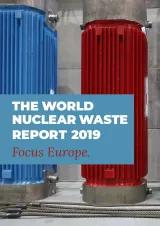The World Nuclear Waste Report 2019
The final disposal of nuclear waste poses major challenges to governments worldwide. No country has a final disposal site for nuclear waste in operation yet; Finland is the only country that is currently constructing a permanent repository. Most countries have yet to develop and implement a functioning waste management strategy for all kinds of nuclear waste.
Governments differ widely on their nuclear waste approaches: in trying to find a final repository, how to classify nuclear waste, which safety standards to require from operators, and how to secure funding for the ever-growing costs to pay for all of this.
With reactors across the world approaching the end of their lives, decommissioning and dismantling of nuclear power plants will become increasingly important. This process will produce even more radioactive waste. In absence of final disposal sites, most of the high-level waste and spent nuclear fuel must be stored for many decades, challenging the safety requirements for storage facilities and causing much higher costs than previously estimated.
Overall, there is a lack of understanding about how countries around the world are trying to address the complex challenges that nuclear waste poses. The World Nuclear Waste Report aims to change that. This first edition focuses on Europe and presents the latest facts and figures on nuclear waste and its challenges.
Slides of the presentation in Brussels are available here.
Find The World Nuclear Waste Report - Focus Europe online:
www.WorldNuclearWasteReport.org
In 2020 the report will be published in French and Czech. The report is licensed under a Creative Commons License (CC-BY-SA). Texts and figures can be used with indication of the sources.
Product details
Table of contents
1. INTRODUCTION
2. ORIGINS AND CLASSIFICATION
2.1 Types of waste: the nuclear fuel chain
2.2 Waste quantities and activity
2.3 Classification systems and categories
2.4 Summary
3. QUANTITIES OF WASTE
3.1 Reporting obligations
3.2 Waste quantities along the supply chain
3.3 Reported waste quantities under the Joint Convention
3.4 Summary
4. RISKS FOR THE ENVIRONMENT AND HUMAN HEALTH
4.1 Radiation risks of nuclear waste
4.2 Risks from uranium mining, mine tailings, enrichment, and fuel fabrication
4.3 Risks from operation
4.4 Risks from spent nuclear fuel
4.5 Risks from the reprocessing of spent nuclear fuel
4.6 Decommissioning risks
4.7 Summary
5. WASTE MANAGEMENT CONCEPTS
5.1 Historical background
5.2 The context of nuclear waste management
5.3 Management concepts for nuclear waste
5.4 Interim strategies: storage
5.5 Summary
6. COSTS AND FINANCING
6.1 The nature of the funding systems for decommissioning, storage, and disposal
6.2 Cost estimations and experiences
6.3 Financing schemes
6.4 Summary
7. COUNTRY STUDIES
7.1 Czech Republic
7.2 France
7.3 Germany
7.4 Hungary
7.5 Sweden
7.6 Switzerland
7.7 The United Kingdom
7.8 The United States of America
8. TABLE OF ABBREVIATIONS
9. CONTRIBUTORS
Imprint
